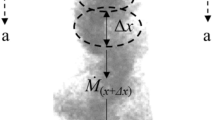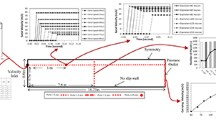Abstract
The sand-driven flow is studied from the continuum viewpoint in this paper. The crux of this work is how to model the stresses of the particle phase properly. By analysing the two-fluid model which usually works in solving gas-particle two-phase flow, we find that this model has many deficiencies for studying the sand-driven flow, even for the simplest case — the steady, two-dimensional fully-developed flow.
Considering this, we have proposed the three-fluid model in which the upward-particles and the downward-particles are regarded as two kinds of fluids respectively. It is shown that the three-fluid model is better than the two-fluid model in reflecting the internal structure of the flow region and the influence of the boundary situations on the flow, and it is advantageous to find an approximate solution in that the main components of the particle phase stresses can be explicitly expressed by those variables in the three-fluid model.
In the end, the governing equations as well as the boundary conditions for the three-fluid model are provided with a discussion.
Similar content being viewed by others
References
Wu Z. and Liu X. W., The present situation and the forecast of the multiphase research of the sand-driven flow, The Mechanics and Practice, 3, 1 (1981), 8–11. (in Chinese)
Wu Z., The Desert Geomorphology, Scientific Press, Beijing (1987). (in Chinese)
R. A. Bagnold, The Physics of Blown Sand and Desert Dunes, Mathuen & Co. Ltd., London, (1941).
Liu D. Y., The Dynamics of Two-Phase Flow, Higher Education Press, Beijing (1993). (in Chinese)
Liu D. Y. and Li H. Z., Discussion on the conditions under which the fluidzed particles can be treated as a continuum and other problems, Proceedings of the 4th National Conference on the Multiphase Flow the Non-Newtonian Flow and the Chemical-Physical Flow, Xi'an (1993), 93–100.
Liu D. Y., Dong F. and He D. L., The analysis of the features of the sand-driven flow, J. of Geography. (in Chinese) (to be appeared)
Liu D. Y., Discussion on the concepts of two-phase flow, multiphase flow, multifluid model and non-Newtonial flow, Advances in Mechanics, 24, 1 (1994), 66–74.
Liu D. Y. and Lu Z. M., Various kinds of random motion and stress in two-phase flows, Proceedings of the 2nd International Conference on the Fluid Mechanics, Beijing (1993).
Dong F., The numerical simultation of the steady, two-dimensional and fully developed sand-driven flow, Master Thesis of IMCAS (1994). (in Chinese)
He D. L. and Gao Y. G., The study of sand saltation movement with high velocity ciencamera, J. of Desert Research, 8, 1 (1988), 18–29.
Author information
Authors and Affiliations
Additional information
Communicated by Li Jiachun
Project supported by the National Natural Science Foundation of China
Rights and permissions
About this article
Cite this article
Dayou, L., Fei, D. A three-fluid model of the sand-driven flow. Appl Math Mech 17, 647–657 (1996). https://doi.org/10.1007/BF00123108
Received:
Issue Date:
DOI: https://doi.org/10.1007/BF00123108




